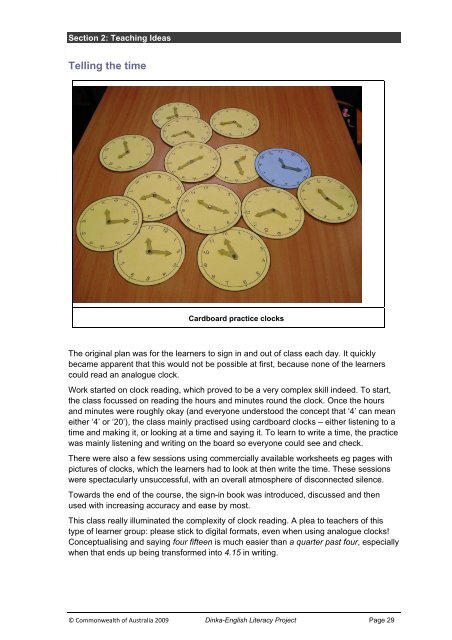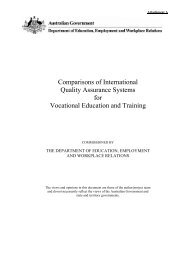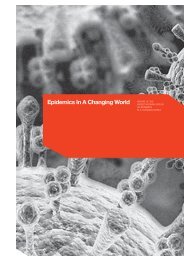First Language (Dinka) Literacy as a Foundation for English ...
First Language (Dinka) Literacy as a Foundation for English ...
First Language (Dinka) Literacy as a Foundation for English ...
You also want an ePaper? Increase the reach of your titles
YUMPU automatically turns print PDFs into web optimized ePapers that Google loves.
Section 2: Teaching Ide<strong>as</strong><br />
Telling the time<br />
Cardboard practice clocks<br />
The original plan w<strong>as</strong> <strong>for</strong> the learners to sign in and out of cl<strong>as</strong>s each day. It quickly<br />
became apparent that this would not be possible at first, because none of the learners<br />
could read an analogue clock.<br />
Work started on clock reading, which proved to be a very complex skill indeed. To start,<br />
the cl<strong>as</strong>s focussed on reading the hours and minutes round the clock. Once the hours<br />
and minutes were roughly okay (and everyone understood the concept that ‘4’ can mean<br />
either ‘4’ or ‘20’), the cl<strong>as</strong>s mainly practised using cardboard clocks – either listening to a<br />
time and making it, or looking at a time and saying it. To learn to write a time, the practice<br />
w<strong>as</strong> mainly listening and writing on the board so everyone could see and check.<br />
There were also a few sessions using commercially available worksheets eg pages with<br />
pictures of clocks, which the learners had to look at then write the time. These sessions<br />
were spectacularly unsuccessful, with an overall atmosphere of disconnected silence.<br />
Towards the end of the course, the sign-in book w<strong>as</strong> introduced, discussed and then<br />
used with incre<strong>as</strong>ing accuracy and e<strong>as</strong>e by most.<br />
This cl<strong>as</strong>s really illuminated the complexity of clock reading. A plea to teachers of this<br />
type of learner group: ple<strong>as</strong>e stick to digital <strong>for</strong>mats, even when using analogue clocks!<br />
Conceptualising and saying four fifteen is much e<strong>as</strong>ier than a quarter p<strong>as</strong>t four, especially<br />
when that ends up being trans<strong>for</strong>med into 4.15 in writing.<br />
© Commonwealth of Australia 2009 <strong>Dinka</strong>-<strong>English</strong> <strong>Literacy</strong> Project Page 29
















